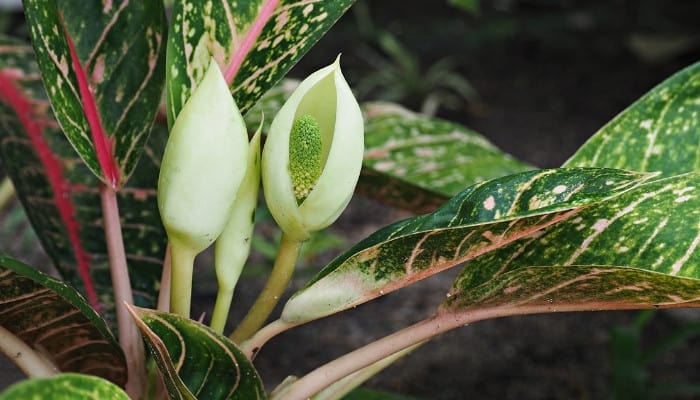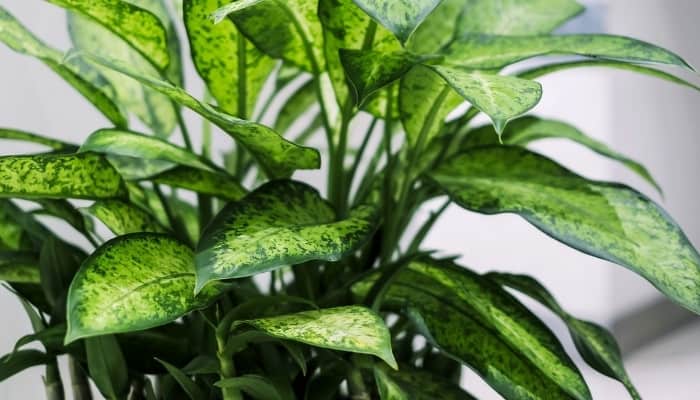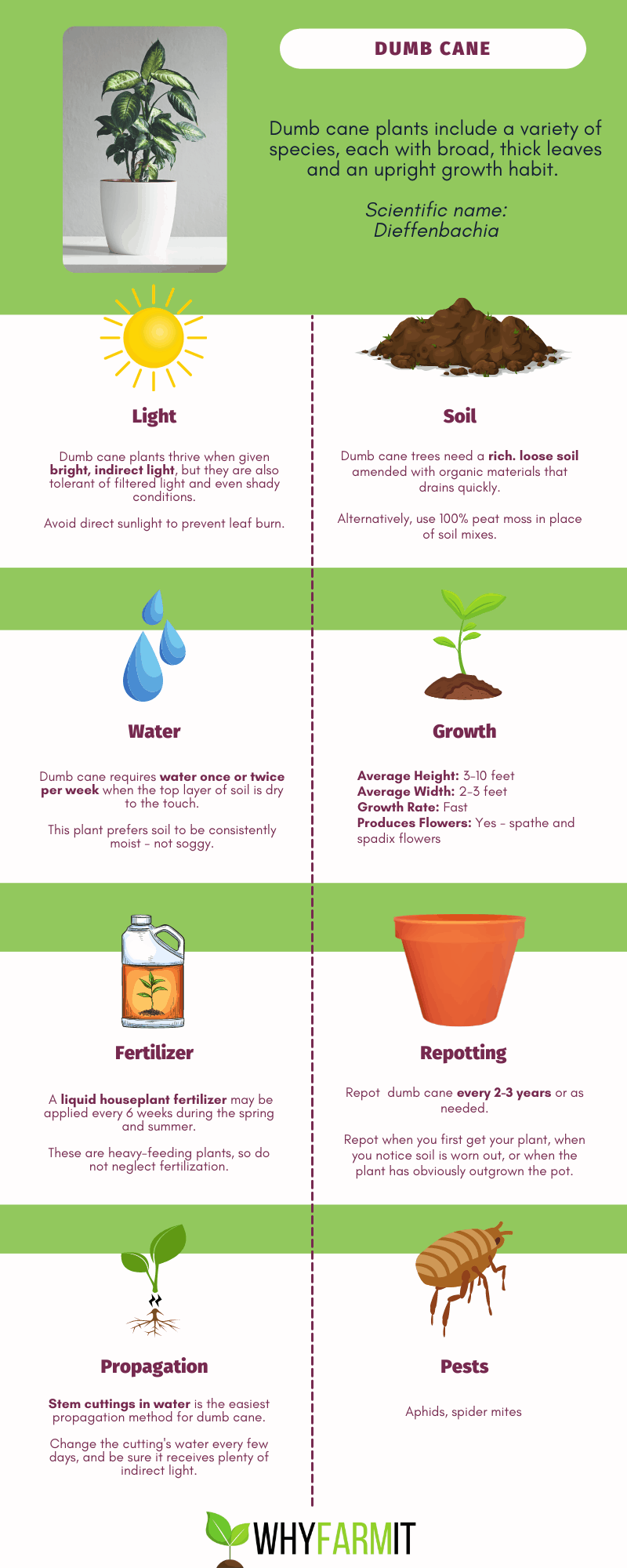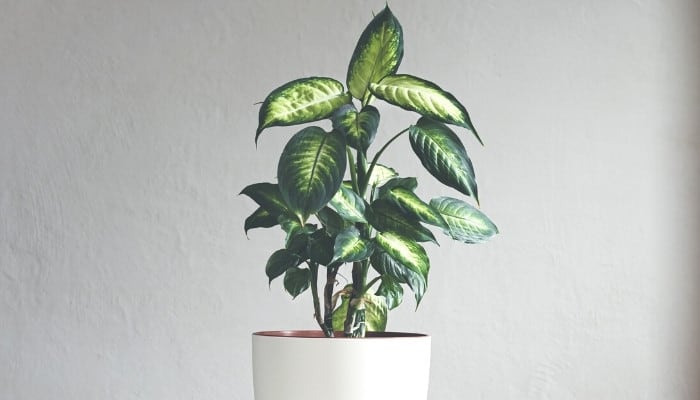If any difficulties prevent you from rewriting the given text, please reply with the error message: Unable to process the request due to encountered difficulties. Dumb cane, whether referred to as Dieffenbachia amoena or D. senguine, is an attractive tropical houseplant that is highly favored for its aesthetic appeal.
Hailing from Mexico, Argentina, and the West Indies, dumb cane is a beautiful species that does significantly better indoors than many common houseplants.
If you’re new to caring for dumb cane plants, you’re going to have a small learning curve.
How do you care for dumb cane? Dumb cane requires soil that is rich in organic matter and drains well. Indirect bright light or slightly shady conditions are all acceptable, but avoid direct sun. Keep temperatures of 62°F to 80°F, and maintain at least 60% humidity. Water once or twice weekly, and fertilize every 6 weeks.
Caring for Dumb Cane: Basic Guidelines
Read on below and discover everything you need to know about how to care for Dumb Cane plants!
Complete Care Guide for Dumb Cane
Caring for dumb cane isn’t really as hard as it may be cracked up to be. That said, it does require a somewhat steady amount of attention throughout the year.
Below, we discuss the most important aspects of caring for dumb cane plants in depth.
Dumb Cane at a Glance
- Plant Type: Herbaceous ornamental
- Scientific Name: Dieffenbachia seguine or D. amoena
- Average Height: 3 to 10 feet
- Average Width: 2 to 3 feet
- Growth Rate: Fast
- Produces Flowers: Yes
- Common Pests: Aphids, mealybugs, and spider mites
- Difficulty of Care: Medium
Ideal Soil for Dumb Cane
Dumb cane requires soil that is rich with organic materials and drains well. That said, it should also be loose, so avoid letting it become compacted.
If you prefer, you may also plant your dumb cane in 100% peat as it drains well and is composed of rich, organic matter.
Dumb Cane Water Requirements
The dumb cane plant likes its soil to be constantly wet but not soggy and overwatered. Rather, dumb cane soil should be lightly moist at all times.
That means watering it at least once or twice per week depending on its location, light, and soil. When the top couple of inches become dry, it is time to water it again.
However, if you are growing your plant in a low-light setting, you may wait until it is completely bone dry before watering it.
Dumb Cane Lighting Needs
Dumb cane is a species that thrives in indirect bright light, filtered sunlight, or somewhat shady locations. However, it may also do just fine in full shade.
This makes it the ideal houseplant.
Avoid placing your dumb cane in full direct sunlight at all costs because full sun will cause its leaves to burn.
If you’re not exactly sure about the differences in lighting conditions, we explain it all here.
Ideal Temperature and Humidity Range for Dumb Cane
Dumb cane should be planted somewhere with a steady temperature of 62°F to 80°F. Again, this makes it a rather ideal plant for growing indoors.
Humidity levels of 60% or higher are most ideal. This plant absolutely loves moisture in the air.
Best Location for Dumb Cane
The best location for your dumb cane plant is somewhere that receives a great deal of light.
That said, unlike many popular house plants, this particular plant may survive in almost any light range except for full, direct sun.
Additionally, the best location for dumb cane is one that has a steady temperature of around 70°F degrees and plenty of humidity (or regular misting).
Dumb Cane Growth Habits
The dumb cane is an extraordinary house plant. They adjust to almost any indoor environment relatively quickly, regardless of low or indirect light levels.
However, the lower the light, the slower they grow.
If growing in bright but indirect light, they may grow as much as 2 inches per month, for a total of 2 feet per year.
With the right temperature and humidity, as well as proper lighting, these plants have a steady growth rate all year, even during winter (indoors, of course).
Fertilization Type & Schedule for Dumb Cane
Dumb cane requires fertilizing several times per year. That’s because they’re considered to be heavy-feeding plants.
As a general rule of thumb, dumb cane should be fed with a strong 20-20-20 fertilizer at least every six weeks. Some gardeners fertilize them as much as every month.
The best way to apply fertilizer to dumb cane is by using a liquid fertilizer and mixing it with water or by using a water-soluble fertilizer, like this highly rated plant food.
Simply water the plants as normal using the liquid solution.
Signs of Nutrient Deficiency
The signs of nutrient deficiency with dumb cane are pretty much the same as with most house plants. If the leaves are becoming limp or yellow, it is a sure sign that they are lacking nutrients.
However, overwatering or the wrong type of soil can also cause the same type of signs even if your soil is well fertilized.
That’s because when your dumb cane is overwatered it struggles to uptake nutrients in sufficient amounts.
The most common nutrient deficiencies found in the dumb cane are nitrogen and phosphorus.
If you are fertilizing your plant every four to six weeks as suggested, this should never be an issue for your plant.
Pruning Dumb Cane
Dumb cane pruning is relatively simple; cut the stem back about 6 inches at a 45-degree angle. Make your cuts slightly higher than the nearest node (bud-like parts with a leaf attached).
Aim to prune between one-fourth and one-third of the plant’s growth. Removing more than a third of the plant may put it into shock or even kill it.
The new growth will develop directly below your cuts, so place them carefully.
Make sure that you always use a sharp and sterilized tool when you go to prune your dumb cane or any other houseplant for that matter.
Does Dumb Cane Produce Flowers?
Dumb cane, unbeknownst to many, does indeed actually produce flowers. On the top of the plant, the male parts flower, and near the base of the plant, female flowers grow.
Dumb cane flowers have off-white-colored flowers, a spathe and spadix variety, and are often hard to spot without directly looking for them.

Is Dumb Cane Toxic?
Dumb cane plants are technically poisonous for humans and their pets. They are especially “dangerous” to children and dogs, as they are the most likely to try eating them.
Dumb cane contains calcium oxalate but not in lethal quantities. However, be sure to wash your hands after handling it, even if you don’t have kids, cats, or dogs.
Be aware that dumb cane will cause your throat to swell up if ingested. That said, it won’t kill you because it isn’t lethal.
Dumb Cane Propagation
Propagating dumb cane is really easy. All you need to do is cut 4- to 6-inch sections from the stem, remove the leaves, and stick them in glasses or jars of clean water.
Make sure to change the water every few days if you want the cuttings to root well.
Also, keep the container with water and clippings in a spot that receives plenty of indirect sunlight and warmth.
Avoid leaving your cuttings in the direct sunlight or you’ll end up with rotted plant matter rather than healthy clones.
Repotting Dumb Cane
Dumb cane is an easy plant to repot. Just make sure you take extra care not to break the main roots in the process and all should be well.
In the next section, we discuss when and how to repot your dumb cane.
When To Repot Dumb Cane
There are several times when repotting dumb cane is necessary:
- When you bring it home from the store (or start it in a small pot).
- When the soil is old and worn out.
- When it has outgrown its pot.
- To prevent it from becoming rootbound.
That said, if your dumb cane is cared for properly, it shouldn’t require repotting more than once every two to three years.
That is why using the correct soil and regularly fertilizing is absolutely crucial.
A side note: If your plant becomes seriously overwatered, make sure to repot it right away with fresh, dry soil.
Signs That It’s Time To Repot
- Leaves are constantly droopy and wilting
- Soil is drying out too quickly
- Soil stays wet for too long
- Leaf drop is occurring regularly
- An odor is coming from the soil
How To Repot Dumb Cane
The most straightforward and effective way to repot your dumb cane is to remove the entire plant from its old container and gently untangle its roots.
Fill the new container up 1/4 to 1/3 of the way full with soil and then place the roots spread out inside before continuing to fill the pot with soil.
Dumb Cane Common Problems & Solutions That Work
Caring for dumb cane plants is pretty simple, but like any other plant, they do have some common problems you should be aware of:
Dumb Cane Common Pests
The dumb cane plant is relatively pest free if kept indoors and properly looked after. However, no plants are guaranteed to stay pest free forever.
Aphids, spider mites, and mealybugs are the most common pests to bug dumb cane plants.
Aphids
- Signs of Trouble – Aphids show up as a bunch of micro-dots gathered on stems and leaves. Dry soil, plant crowding, and stress invite aphids to your plant.
- Solution – Aphids are easy to wipe from plants, by hand after spraying with mild soapy water if their numbers aren’t too high. Lightly dusting your plants with flour also helps discourage aphids.
- Prevention – Keeping your plant happy and healthy, including consistently moist soil, helps prevent aphids.
Spider Mites
- Signs of Trouble – Spider mites often give their presence away by leaving behind silvery stripes and dots on your plant’s leaves and stems. If you look closely you may also notice tiny little webs with white dots in them (the white dots are the spider mites).
- Solution – Apply a tropical-friendly pesticide (or a homemade alcohol-water mix of 16 ounces of water and half a cup of alcohol) to the leaves and stems.
- Prevention – Apply neem oil to leaves and stems. (I use this organic neem.)
Dumb Cane Common Diseases
A few of the most significant common diseases that may affect your Dumb Cane include:
Bacterial Leaf Spot
- Signs of Trouble – Bacterial leaf spot is noticeable due to its little dark green, dark brown, black, gray, or tan spots.
- Solution – Remove the infected parts of the plant.
- Prevention – Avoid overhead watering, and only apply water to the root zone.
Anthracnose
- Signs of Trouble – Anthracnose can be recognized by its yellow halos and circular brown spots. The spots or halos may also have tiny black dots which are actually a fruiting fungus.
- Solution – Remove affected leaves and apply fungicide (like this copper fungicide)to the healthy parts of the plant.
- Prevention – Avoid watering the plant from overhead.
Myrothecium Leaf Spot
- Signs of Trouble – Myrothecium shows up in the form of big ugly gray spots that affect leaf margins and tips. Leaves affected by Myrothecium leaf spot may also have rings of fruiting fungus on their undersides.
- Solution – Remove dead and infected leaves, and apply fungicide to the healthiest parts of the plant.
- Prevention – Avoid getting the leaves wet when watering.
Other Common Problems
A couple of other common problems that you may encounter with your Dumb Cane are yellowing leaves or burnt tips.
Yellowing Leaves
- Signs of Trouble – The main reason for yellow leaves is overwatering or underwatering.
- Solution – Correct by removing dead yellow leaves, and water the plant more or less frequently as needed.
- Prevention – Make a habit of checking the top inch or so of the soil for moisture, when it’s dry it’s time to water.
Brown Leaf Tips
- Signs of Trouble – Brown leaf tips may show up for one of two reasons; too much direct sunlight or too much fertilizer.
- Solution – Trim leaves up and correct the lighting or fertilizing issues.
- Prevention – Take care to avoid direct sunlight and fertilize less often.
Dumb Cane Common Questions

Why Is It Called Dumb Cane?
The dumb cane plant received its name due to the speechlessness that may be induced by chewing the plant’s stem.
The temporary inability to speak is due to the raphides, or stinging crystals, which consist of calcium oxalate.
Does Dumb Cane Purify Air?
Dumb cane has thick foliage that removes harmful contaminants and toxins out of the air.
Specifically, these plants greatly reduce xylene and toluene by significant amounts. That is why it sits at the top of the list of houseplants that purify the air.
What Are Popular Dumb Cane Varieties?
There are numerous types of dumb cane, or Dieffenbachia, that are more popular than other varieties. Some of the most popular varieties include:
- Dieffenbachia amoena
- D. ‘Camille’
- D. ‘Camouflage’
- D. ‘Carina’
- D. ‘Compacta’
- D. ‘Delilah’
- D. ‘Honeydew’
- D. ‘Mary’
- D. ‘Triumph’
- D. ‘Tropic Marianne’
- D. ‘Tropic Snow’
- D. ‘Snow’
- D. ‘Sarah’
- D. seguine
- D. ‘Sparkle’
- D. ‘Star Bright’
- D. ‘White Etna’
- Variegated
4 Key Tips for Success With Dumb Cane
Keep the Top Inch of the Soil Moist Constantly
The best way to ensure that your dumb cane is taking up enough water and nutrients as well as staying moist but pest free is by keeping the top inch or so of the soil in its container consistently wet (damp, not soaking wet).
Keep It Indoors Away from Heaters and Air Conditioners
Keeping your dumb cane in a state of thriving is most successfully achieved by locating the plant somewhere indoors where you control its environment entirely.
The best location is somewhere well lit and away from air conditioners or heaters.
Mist It Often If Your Home’s Environment Isn’t Humid
If the level of the air around your dumb cane is less than 50 to 60% humidity, your best bet is to mist the plant as often as daily to help achieve proper moisture levels.
That said, don’t let your plant’s temperature drop below 62°F.
Keep Your Dumb Cane Out of Direct Sunlight
Dumb cane is a houseplant that may survive in nearly any lighting conditions, even full shade.
The only light condition it can’t stand is also the one that will surely zap the life out of it: full and direct sunlight.
A Final Word About How to Care for Dumb Cane Plants
Dieffenbachia is a fairly simple plant to care for. Learning as much as you can about caring for the species ensures yours will live long and prosper!
Feel free to refer back to this guide as often as necessary while you’re learning how to care for dumb cane.


